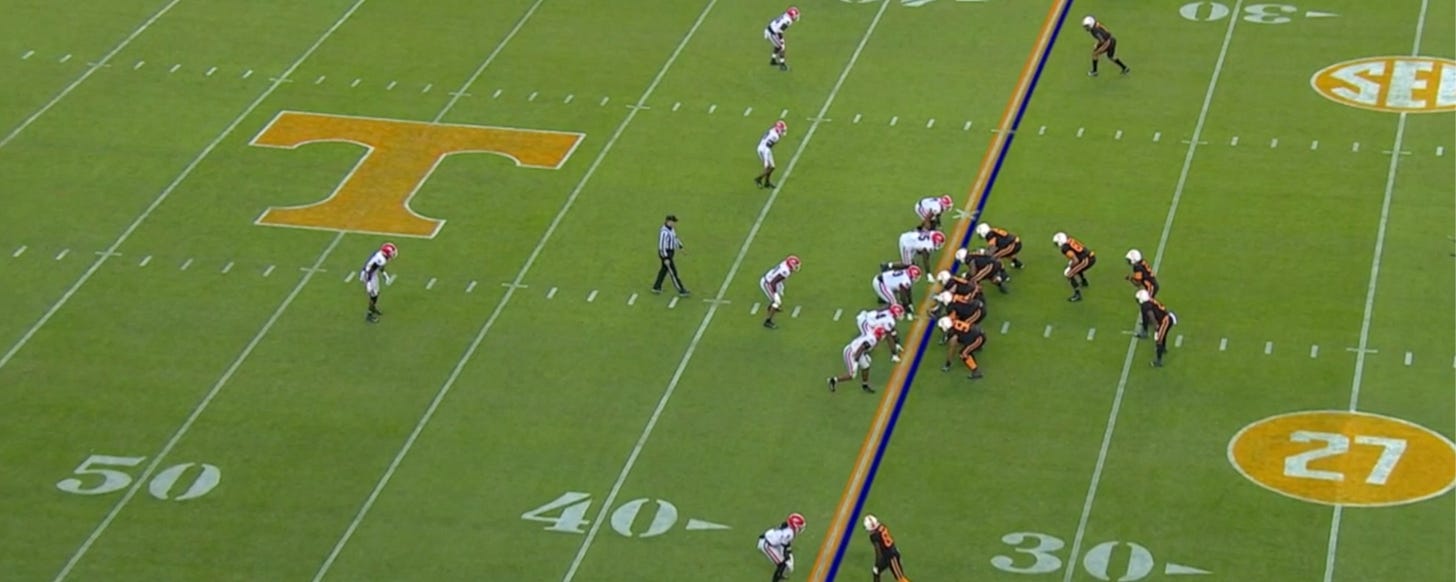Running a 5-1 Bear Front vs 2-Back Spread
MQ takes a look at Georgia's Bear Front vs Josh Heupel's (Briles) Tennessee offense.
Georgia’s defense has been the main story for most of the college season. With no true front runner for Heisman, the focus was squarely on the dominance on the field in Athens, Georgia. But, for several years now, the Bulldogs have been building something special with the 2021 season a culmination of Kirby Smart and staff work thus far.
When elite recruiting and development meets elite coaching, Georgia's results are what happens. Though Alabama took some of the shine off of Georgia’s elite defensive run in their 41-24 ‘21 SEC Championship victory, you cannot ignore the production of the defense. The Bulldogs led the nation in Defensive EPA per game at -18.28 (Wisconsin was 2nd at -15.77) and dominated the game through the air until Alabama.
During his Nike Coach of the Year Clinic, Smart made a point to talk about Georgia’s commitment to stopping the run so that they could commit more to the passing game. The move to focus on the run game may seem counterintuitive in today’s pass-centric game, but Smart knows what he is doing. By securing the fits upfront with as little manpower as possible, the Bulldogs can then shift players away from the box to flood the zones. With early-down motion and passing on the uptick in the college game, it makes sense for Georgia to try and live in the grey. To do that, the Bulldogs need a dominant D-line.
Smart told ESPN earlier in October that the D-line was using nine to ten players. In terms of depth, that is unheard of. In most cases, even at the elite level, teams can usually rely on three or maybe four players for the two positions inside and outside. That creates a three-man rotation to keep players fresh. At Georgia, there is little to no drop-off. In the same ESPN article, Smart told the reporter that an NFL scout told him five to six of the current front could be drafted next Spring.
Smart and his staff have designed a way to play gap-and-a-half by winning the matchups up front. The ability to win those matchups increases as the game goes along because the D-line stays fresh while the offense rarely sub on the O-line. Like the 2020 Rams that created five-man fronts to dominate their opponents, the Bulldogs are doing the same. Whether it is their four-man front or Mint package (three-down), Georgia can transition smoothly from one front structure to another with many options.
Related Content: Georgia’s Mint Front
One extension of the Tite Front used by Georgia (Mint/Base) is a 5-1 alignment that features the typical Base front with two EDGEs and three interior linemen. Behind the five-man front, there is a sole Linebacker playing a ball-fit (reading the RB). This system is nothing new; defenses have been using 5-1 alignments with single-high coverage for decades. However, what is unique and illustrated by the Rams last year was a two-high shell behind it.
Related Content: The Modern Bear Front (vs Notre Dame ‘17)
Using a five-man front against Spread teams allows the defense to create one-on-one blocking, especially versus Zone-centric offenses. If the D-line is dominant, and Georgia’s was, the defense can use the depth of the Safeties in a two-high shell to counter play-action, pre-snap motion, or RPO passes. Winning the one-one-ones and playing gap-and-a-half is crucial to the success of the front. When a dominant D-linemen (insert Aaron Donald for the Rams) is introduced, the defense can build a natural wall and funnel the RB into a phonebooth.
Related Content: The Argument For A Light Box (‘20 LA Rams Defense)
The ability to control the line of scrimmage (LOS) allows the Bulldogs to play more passive in the secondary when it comes to run fits. Early in the season, Georgia had a -.5 EPA per pass. That means every time an offense passed; they lost half a point! Though Georgia cooled off a bit, according to CFB Graphs, the Bulldogs finished the regular season with a passing EPA of -.309 (Notre Dame was second with -.241). In addition, the ability to stuff the LOS with four or five defenders allowed the Bulldogs to sit back and attack WRs as they worked down the field. As Smart explained in his clinic, winning upfront allowed them to win in the back.
Keep reading with a 7-day free trial
Subscribe to MatchQuarters by Cody Alexander to keep reading this post and get 7 days of free access to the full post archives.




